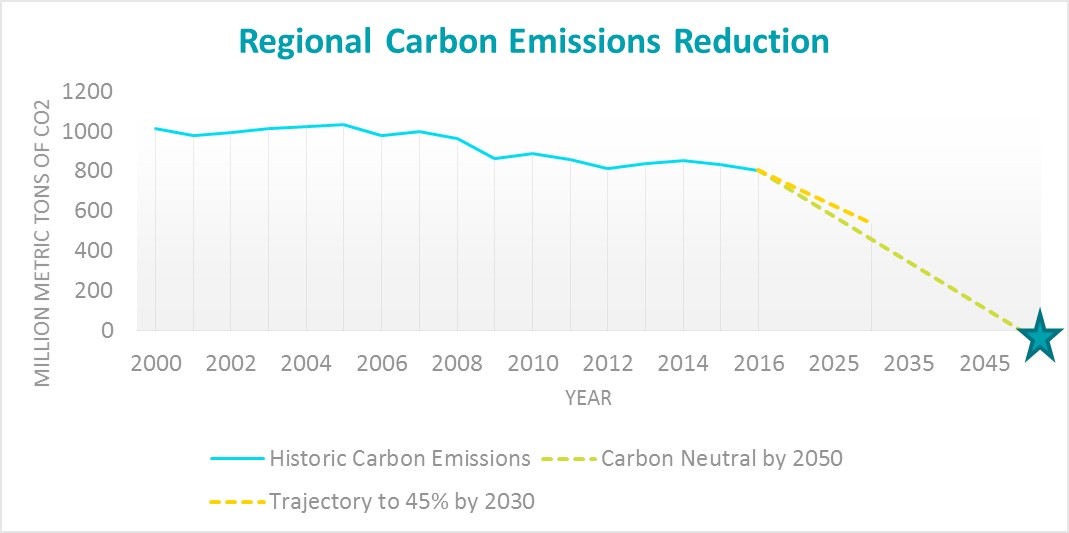
By Samantha Caputo | Mon, November 4, 19
States throughout the NEEP region recognize the need to address climate change and transform the way we generate and use energy. The global scientific consensus is that we need to decarbonize our economy 45 percent by 2030 and reach carbon neutrality by 2050 in order to reduce the chance of exceeding 1.5 degrees Celsius. We are already experiencing the impacts of climate change and exceeding 1.5 degrees will put us over the tipping point of irreversible damage affecting generations to come. This transition is faster than states have planned for as many throughout the region have adopted 80 percent by 2050 goals through legislative mandate or identified it in a climate action plan. New York is the first state to update its climate goals with the Climate Leadership and Community Protection Act, mandating carbon neutrality by 2050 and ensuring at least 35 percent of the benefits are received by disadvantaged communities.
|
State |
Baseline Year |
Near-term Goal |
Interim Goal |
Long-term Goal |
Source of Goal |
|
Connecticut |
2001 |
10% by 2020 |
45% by 2030 |
80% by 2050 |
|
|
Delaware |
2008 |
30% by 2030 |
|
|
|
|
Maine |
1990 |
10% by 2020 |
45% by 2030 |
80% by 2050 |
|
|
Maryland |
2006 |
25% by 2020 |
40% by 2030 |
|
|
|
Massachusetts |
1990 |
25% by 2020 |
|
80% by 2050 |
|
|
New Hampshire |
1990 |
10% by 2020 |
20% by 2035 |
80% by 2050 |
|
|
New Jersey |
2006 |
equal 1990 by 2020 |
|
80% by 2050 |
|
|
New York |
1990 |
40% by 2030 |
|
85% by 2050 +15% CO2 capture |
|
|
Pennsylvania |
2005 |
26% by 2025 |
|
80% by 2050 |
|
|
Rhode Island |
1990 |
10% by 2020 |
45% by 2035 |
80% by 2050 |
|
|
Vermont |
1990 |
50% by 2028 |
|
75% by 2050 |
|
|
Washington D.C. |
2006 |
50% by 2032 |
|
100% by 2050 |
|
|
West Virginia |
N/A |
|
|
|
|
For states, aligning with current scientific consensus is critical, however, identifying a plan for achieving these goals can be challenging because it requires an overhaul of our economy. In order to achieve these long-term carbon reduction goals, states must keep themselves on track with short-term and interim targets. Furthermore, specific and actionable goals around energy efficiency, electrification technologies, and low emissions energy can help states achieve higher carbon reduction targets.

Addressing climate change is an economy-wide issue; in order to decarbonize the economy, there must be an aggressive and comprehensive approach towards decarbonizing buildings. Buildings account for 31 percent of emissions in the NEEP region. In order to assist states in achieving this goal, NEEP developed a Building Decarbonization Public Policy Framework to offer up a pathway. A successful transition to zero carbon [buildings] will require market transformation with advanced technological solutions, and equitable and fair policy mechanisms.
Critical policy areas include comprehensive state and utility policy, building regulation, federal regulation, and alignment with evaluation, measurement, and verification (EM&V). In addressing building emissions, it is important to consider these strategies:
- Enabling grid optimization with building-level zero carbon energy production and developing power systems with zero-carbon energy;
- Deploying widespread energy efficiency measures, especially deep energy retrofits;
- Fuel switching gas and heating oil with renewable fuels, such as renewable electric and thermal technology;
- Integrating buildings as grid assets;
- Implementing zero energy/carbon building energy codes; and
- Establishing strong performance standards for new and existing buildings.
This policy framework highlights innovative and advanced policy mechanisms that can be used to achieve deep decarbonization of the building sector. Comprehensive policy can transition the fossil fuel economy into a new, green economy that is environmentally sustainable, economically secure, and socially just. NEEP hopes this framework serves as a bit of inspiration to the region’s policymakers and stakeholders to move these elements of advanced efficiency forward in states and communities. It will take a collective, sustained effort to achieve the promise of a low-carbon energy system. We encourage leaders across these areas to make building decarbonization a priority, and to use existing forums and programs to advance solutions and conduct research to fill gaps. To read more about the framework, visit this page.
